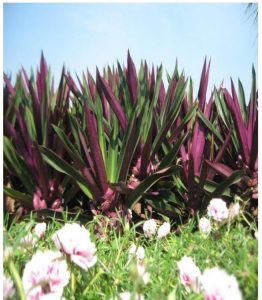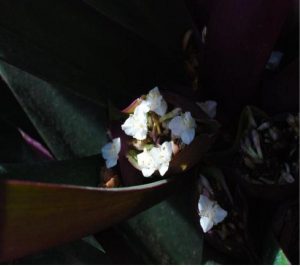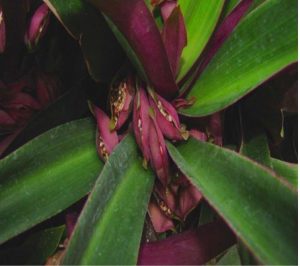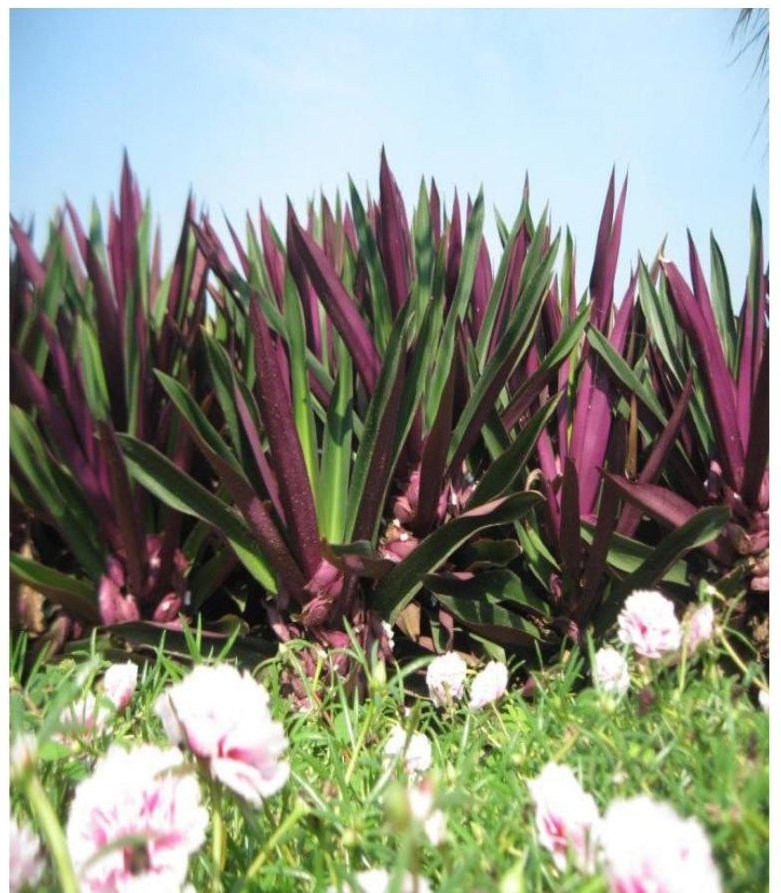By Manzanillo Sun Writer from the November 2014 Edition

Tradescantia spathacea or pallida ‘Purpea’, Rhoea spathacea, or Rhoea discolor
Family: Commelinaceae
(Also known as Moses-in-the-Boat, Moses-in-the-Cradle, Moses-inthe-Basket, Moses-in-the-Bulrushes, Boatlily and the ever popular Purple Leafed Spiderwort.)
(This plant should not be confused with Acanthus molli, or Acanthus spinosus – Bear’s Breeches or the Scolymus hispanicus Spanish Oyster Plant or with the four feet tall, grass-like Tragopogon porrifolius Salsify that is a member of the Asteraceae (sunflower) family and has an edible root with the flavor of oysters. Each of these are sometimes called Oyster Plant as well. And, yes, I agree, it’s all, often, quite confusing!)
Now let’s be honest. Often we find ourselves needing a solid, stable, “comfortable and fun to be around as well as always ‘there for us’” plant . . . just as my wife is for me. Such is the Oyster Plant. . . . well, without the “Honey Do” list!
Whistler describes the Oyster Plant as being “Distinguishable by the coarse, clump-forming, herbaceous habit, narrowly lanceolate (no, that is not a prince in King Arthur’s court) leaves purple on the lower surface and lacking a midrib”. I, an old country bumpkin gardener, might say that they are “no nonsense, good looking, low maintenance, fast growing, easy to grow ground cover. (Of course, that may be why he has a book and I don’t!)
In a bit more simplified way of description, each one has a dozen (more or less), erect, broad, sword-shaped leaves that are a dark green on the top and a striking, deep purple underneath. Its flowers are, well, perhaps more interesting than outright attractive. They’re comprised of three, small, white papery petals all crowded together in purple, boat-shaped bracts (hence the one name Moses in the Boat) down among the leaves.
Suffice it to say from the outset, they are comfortable in sun or shade and almost seem to thrive on abuse and are extremely functional having an array of practical and attractive application.
Drench them in water or forget to do so for protracted periods this stalwart plant generally doesn’t seem to mind. An intriguing, strong spirited character, regardless of our lack of attention, it just goes on about doing its job. It’s a fast grower and makes a great ground cover, potted plant for the terrace or tropical flower bed border/edging plant and looks great planted around rocks or boulders.

The short version of it is that (those with a brown thumb take note) the Oyster Plant is very hardy and quite easy to grow in that it propagates, on its own, via its roots or wind blown seeds or, by us, through cuttings.
It is native to West Indies, Mexico and Guatemala and in this latter locale coloring extract is taken from its all purple leaves for use in cosmetics. Warren, in his book, warns that “the entire plant is poisonous” so, simply, don’t eat ‘em!

This attractive succulent can grow up to two feet. There are varieties that are solid green or variegated foliage of striped red and yellowish green. Here in Ola Brisa Gardens we also have its cousins, Purple Heart (T. pallida), Wandering Jew (T. zebrina) and a ‘dwarf variegata’ variety. Regarding this latter one I read on line that “With its subtly attractive texture and color (the) dwarf oyster has a neat appearance in a dense bed and works well in formal or casual landscapes.” That’s a pretty correct assessment.
There are those who feel that the Oyster Plant is an invasive nuisance. In fact, Llamas advises that they may “infest flower beds, container plants, palm trunks, gutters and roof tiles”. Granted, they are tough, growing and propagating without attention or care in unattended or abandoned areas quite well but I tend to think that they are merely imbued with a hardy, pioneer spirit like my great grand parents – and, as a result, l like ‘em a lot!
As to preferences in homesteads, they prefer alkaline or slight to moderately salty, well draining soils.
Beyond that, another negative aspect asserted by some is the claim that it causes a rash/irritation on both humans and pets. I have not so noted in my dealings with them but it might be good information to bear in mind.
Here in Mexico, I have heard that this plant is used to cure wounds or infections and that the leaf “juice” can be used to disinfect.
The proverbial bottom line is that this is a hardy, good looking plant of wide application
For back issues of “Roots”, gardening tips, tropical plant book reviews and videos of numerous, highly unique eco/ adventure/ nature tours, as well as memorable “Ultimate Experiences” such a Tropical Garden Brunches and Spa Services, visit us at.. www.olabrisagardens.com
Download the full edition or view it online
Manzanillo Sun’s eMagazine written by local authors about living in Manzanillo and Mexico, since 2009




You must be logged in to post a comment.